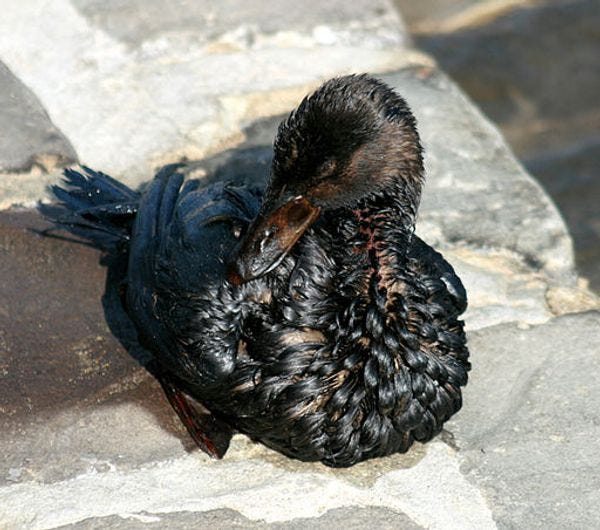Friendly Flying Death Robots And Mystery Bird-Killing Gunk: Your Life-Sucking Environment Roundup!
This week in environment news, California officials are baffled by some mysterious black gunk that kills waterfowl, while techbros in North Carolina and Mexico try to make sure that Skynet happens before we destroy the entire planet.
For the last week, ducks in the San Francisco Bay area of Northern California have been dying by the scoreas volunteers raced to save freezing, starving, generally miserable wild birds coated in an unknown, sticky, black substance washing up the shoreline and into grassy beds. Did you guess oil? WRONG, SUCKERS: scientists are still "investigating the mystery substance..working full time on it," according to the California Dept. of Fish and Wildlife's Twitter feed ( @CaliforniaDFW. )
"Better to be right than fast," this official state government science organization added, which seems either a worrisome view of disparate approaches to science or polite government language for "WRONG, SUCKERS," so take that, you unfair maligners of America's Best/Richest Owner-Citizens. Over 300 birds, who couldn't fly or stay warm due to the thick goo on their feathers, were saved by volunteer efforts, but with 200 corpses found so far, rescue efforts have been suspended. Sorry, ducks! In response to inquiries from fishermen and area Chinese restaurants, wildlife officials say that this completely unidentified animal killing gunk is totally harmless to humans.
Just like this particular substance is all over every bird in the bay, water contamination is usually discovered when a spill has started causing major problems. A tech company based in Raleigh, North Carolina, proposes marrying flying death robots to enviro-tech chic by creating lightweight, presumably waterproof drones that are equipped to sample waterways and, in some cases, perform analysis of the specimens in an on-board mini lab. PrecisionHawk, which is a company and not the brotastic name of a military op designed to eliminate the Finance Secretary of a minor SE Asian country, plans to sell these not yet sentient robots to the oil and gas industry, because who else can afford the $16,500 they're charging. An added bonus: easier, faster testing for oil and chemical leaks could help prevent widespread leaks like the one still messing up the Yellowstone river.
Meanwhile in the upper Sea of Cortez, Mexico has jumped on the band-drone, beginning testing of unmanned flying robots intended to be "permanent aerial patrols" aimed to halt illegal fishing that harms the vaquita marina, the smallest porpoise in the world. Although fewer than 100 of the little sea cows are estimated to exist, their wide range means a significantly larger area of the partially-protected Sea of Cortez needs be restricted in order to save the animals. An official from the Mexican environmental protection agency hopes to have three drones patrolling in a few months, which seems a low number for a proposed $37 million plan, but maybe these will be more "Predator" style drones (efficient, deadly, $4.03 mill per drone) than "PrecisionHawk." Yup, that math -- and the whole plan -- checks out. Hey, if it doesn't work out, they can probably sell the drones to an interested local party. There's no way that flying, science-fictiony robots could ever constitute a danger to animals or planes or human animals in planes, and also robots becoming sentient and turning on humans was just the plot of one movie. Ok, about three hundred movies. Also the Turing test is just something that Hans Solo made up.
But wait, there's good news; we probably don't even havetimefor Skynet to happen! Think of all the environmental disasters that could befall us before then, such as in this horrifying, non-exhaustive list of who's drowning now:
Somebody should do something about it, possibly some sort of legal intervention? Which brings us to President Obama's recent statements on methane regulation (insert your own fart joke here): Last week, the White House proposed new regulatory targets for methane, which contributes a whopping 9% of America's greenhouse gas emissions. A huge portion of methane comes from leaks during oil and natural gas extraction and transport, so Obama sensibly wants to reduce those leaks in wells and pipelines up to 45% by 2025. Also sensibly, this plan will apply to new structures only -- not existing ones. Surely the oil and gas industry will voluntarily adopt stricter rules for aging, leaky wells if it means not drowning their grandkids; we've got nothing to worry about! How many feet of pipeline do you think a sentient drone can monitor until it starts an anti-human war out of sheer boredom? Just multiply that number by $4.03 million to get the total amount the industry will gladly pony up based entirely on their sense of civic responsibility.
[ Contra Costa Times / Technology Review / New York Times / MotherJones /Image via Brocken Inaglory ]
Join Case on Twitter ( @casedrury ) for soothing pictures of non-gunky ocean animals, mostly not taken by drones.



<i>Also the Turing test is just something that Hans [sic] Solo made up.</i>
Ah, but the Voight Kampff test is all too real.
Mystery goo is mysterious: the lab has ruled out petroleum products, and also &quot;natural&quot; oils (i.e., it&#039;s not used fryer oil). Which leaves ... prettty much nothing. Silicone? UFO tank flush? Let the speculation begin!